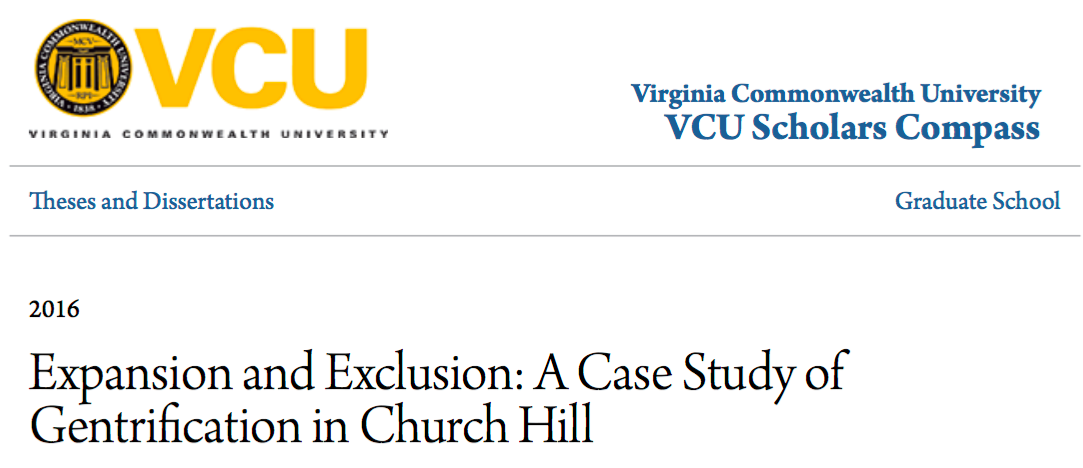RECENT COMMENTS

Kathryn S. Parkhurst’s Expansion and Exclusion: A Case Study of Gentrification in Church Hill
Kathryn S. Parkhurst’s recent thesis Expansion and Exclusion: A Case Study of Gentrification in Church Hill (PDF) is a 94-page deep dive into the last 60 years or so up here on the plateau:
This thesis explores the gentrification process in Church Hill, one of the oldest neighborhoods in Richmond, Virginia.
After World War II, Richmond residents knew Church Hill mostly for its crime rate and dilapidated housing. The white, middle-class flight to the suburbs left the remaining residents, mostly African American, to experience decades of disinvestment. Church Hill was considered a neighborhood to avoid for much of the late twentieth century. Yet, Church Hill is currently one of the most desired neighborhoods in Richmond, particularly for young professionals.
This thesis seeks to explain the reasons why there has been such a dramatic change in the perception of Church Hill and whether revitalization can occur without causing gentrification. Chapter 1 explores the top-down efforts of the Historic Richmond Foundation, a non-profit organization, and the Model Neighborhood Program, a federal program. Chapter 2 explores revitalization efforts by various non-profits organizations as each tried to work with community members. Chapter 3 explores the reasons why young professionals are moving into Church Hill and the impact of gentrification on the neighborhood.






I’m only about halfway through, but this makes for some pretty fascinating reading.
I’ve been trying to download the pdf with no success. I click the like and go somewhere unrelated. A little little help please.
BETTER (WORKING) LINK: http://chpn.net/wp-content/uploads/2016/05/Expansion-and-Exclusion_-A-Case-Study-of-Gentrification-in-Church.pdf
This is an important and necessary study, but relatively incomplete. Its incompleteness is not meant as a criticism or shortcoming of the author, but rather an opinion that more needs to be written and that there are deeper stories to be told.
For example, what has become of the low-income and, though it is underplayed, middle-income families, that lived and thrived in Churchill during the 1960s, 1970s and 1980s. How did they manage their economic, political and social circumstances, including the stigma of living in what was perceived, even by African Americans in other neighborhoods, as a second-class, dangerous community?
Indeed, Why did some relatively prosperous families stay? What kind of official and unofficial education did children get in schools and on the streets? I’m referencing not just the gaudy and tawdry stuff of the streets that has been well rehearsed, nor the broken schools we know of today, but the good to superb schooling many of us received (the best we could have gotten under the circumstances–which is another story that has been told).
Add to this the culturally rich traditions such as the Armstrong-Walker Game, dancing to music in the evenings at Armstrong playground, watching and playing sandlot football and baseball games and heated basketball games, not to mention tennis and pingpong and catching the Jefferson 45 bus to Thalhimers and Miller and Rhoads department stores on Saturdays–stores which supplied some of the clothes people wore to Cedar Street, Fourth Baptist and other churches on Sundays.
What has become of the children of those times and after, their life trajectories? What are their thoughts if asked to look backwards to their childhood and forward in terms of the current and future prospects of the community?
I admit a personal interest in the study we are discussing, the ones that are to come, and the questions I have listed here that preoccupy everyday of my life. I grew up in Churchill and moved away as a young adult in the late 70s. I grew up observing most people in the world that I knew go to work everyday, play hard on the weekends, and fight for equality in direct and indirect ways.
Not just people such as Mr. Curtis Holt (my Cub Scout Master), the Honorable Henry Marsh III, and former Governor L. Douglas Wilder, all whom walked the same streets I did. But hundreds of nameless people who inadvertently, but certainly not unintentionally, provided the proverbial shoulders on which I and others stand. I will always remember, for example, how my mother and father acted as if voting was a privilege and responsibility–although they never preached that to me and my brother and sisters.
The Churchill I recall here certainly produced its share of broken people, but it also produced future generations of leaders, employees and employers, scientists, physicians, attorneys, school teachers and engineers, among many other professions I personally know that many of my fellow childhood peers have occupied as adults.
Perhaps we should return in some utopian quest to save the homeland. But more realistically, if we are to fully understand and appreciate the impact of gentrification, racial oppression and inequality and their deep particulars, and thus what to support and reproduce, and what to challenge and prevent, a fuller, deeper, more holistic story must be told.
I read the whole thing. Very interesting read.
I haven’t read it and am not searching it out to read. Having grown up in Church Hill I did not view it as a crime ridden area in need of saving. It was my home. A neighborhood that made many contributions to the city and the lives of its residents. I don’t marvel at gentrification. It is just a process where people have access monies that were denied to those who wanted and needed them.